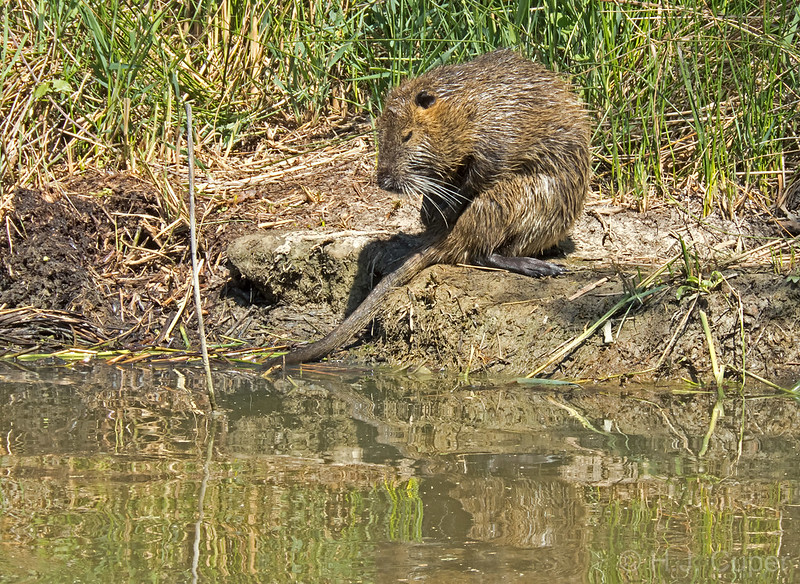Invasive species
Alien species at new sites are not unusual, but if they are classified as "invasive" they are usually a threat to native biodiversity. The threat can be of different nature and can e.g. endanger by transmission of diseases, superiority in competition for habitat and resources or, especially in the case of plants, change the gene pool by crossbreeding with native species. Alien and invasive species have mostly been spread via humans, and increased temperatures in times of climate change give many species an additional advantage.
Invasive?
The American bullfrog was deliberately imported from its native area the eastern part of North America, from the 19th century to Europe, bred and repeatedly released. It was an asset for gastronomy, ornamental trade and served as fishing bait. They compete with native frog and amphibian species for spawning sites, food, and habitat. The frogs' abundance is probably boosted by warm winters, when fewer hibernating American bullfrogs die.
Where?
The American bullfrog lives in still waters rich in plants, such as lakes, ponds and swamps. It prefers warmer waters. The call of the males is quite loud and reminds of ox calls.
Aussehen?
It is one of the largest frog species in the world (15-20 cm in body size), making it larger than all native frog species. The tadpole can also grow up to 14 cm. Recognizing feature of adult animals is the strikingly large eardrum below the eyes. The body is olive green to gray-brown in color and often dark spotted. The sound bladder in males is located on the throat and not on the side as in native water frogs.
Distribution in Luxembourg:https://neobiota.lu/lithobates-catesbeianus/

"Ouaouaron (Lithobates catesbeianus)" by Bouligab is
licensed under CC BY-SA 2.0
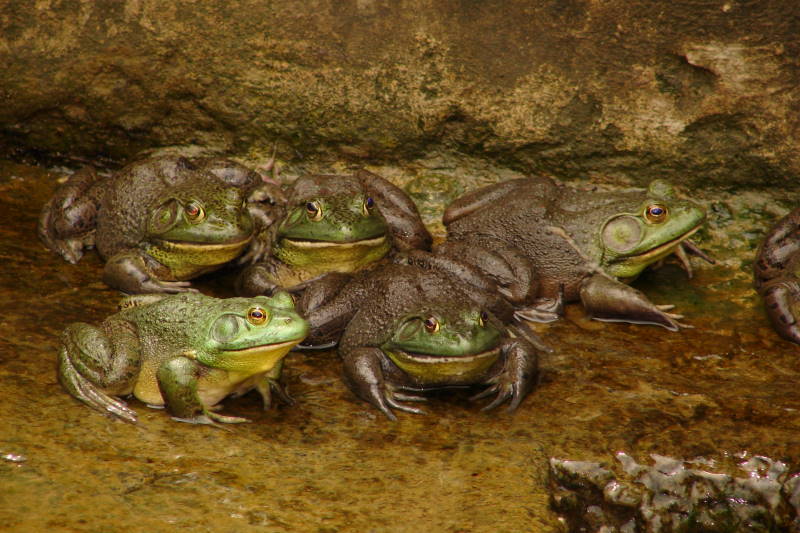
"Lithobates catesbeianus DT [Z Yanzatza] 0803 (14)" by Archivo Murciélago Blanco is licensed under CC BY-SA 2.0
Invasive?
The Armerican skunk abbage or yellow skunk cabbage was spread to Europe through the garden trade and parks and originated in North America. Lysichiton plants can grow up to 1.2 m tall under favorable conditions on semi-shaded, nutrient-rich and acidic sites near bodies of water. They develop leaves up to 50 cm wide. This competitive effect can push back typical animal and plant species, such as sphagnum mosses, marsh violets, and orchids. Lysichiton americanus can thus pose a threat to the vegetation of wetland sites, including, for example, spring sites.
Where?
Amerivan skunk cabbage grows best in nutrient-rich soils, wetlands and moist forests with shade. But also occurs on the banks of standing or flowing water.
Appearance?
SAmerican skunk cabbage is a large swamp perennial with strikingly large, undivided, stalked, tobacco-like leaves that can grow up to 1.5 m long. The plant grows close to the ground and does not grow particularly tall. The attractive inflorescence, a green 12-20 cm long spadix surrounded by a yellow bracts (spatha), appears in early spring before the leaves. Berry fruits with 1-4 seeds each are formed on it. The inflorescence and fruit set is thus similar to that of the native arum. The leaves of the native arum at arrow-shaped, sometimes black spotted leaves that are not longer than 30 cm.
Distribution in Luxembourg: https://neobiota.lu/first-documented-observation-of-lysichiton-americanus-in-luxembourg/
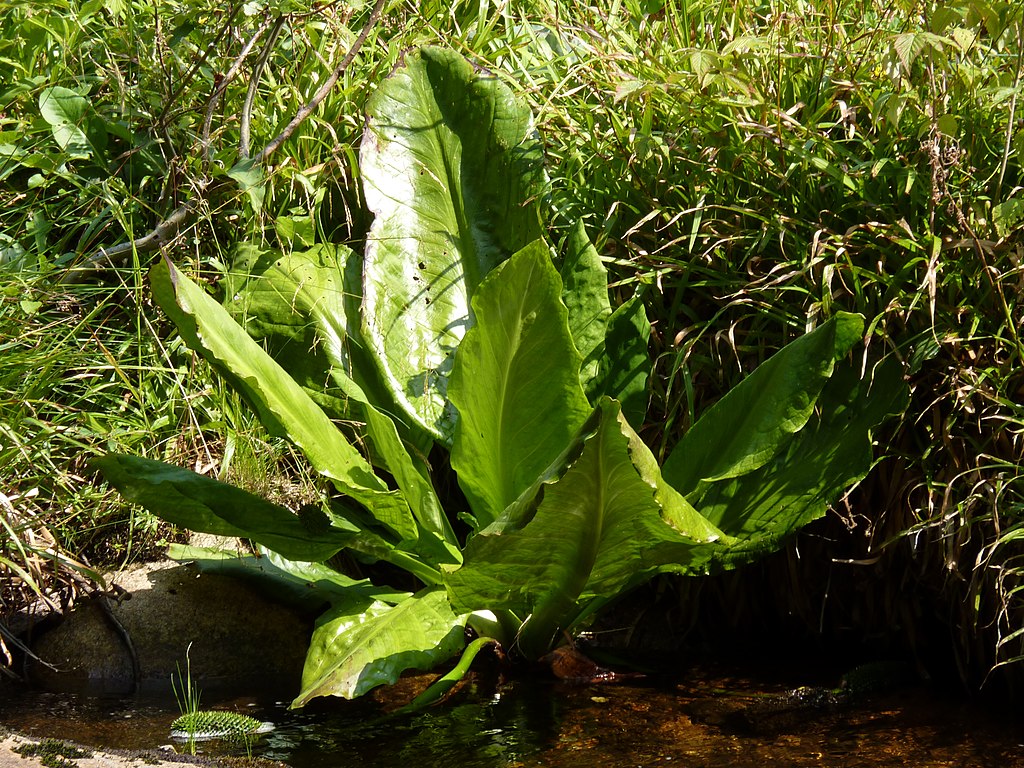
The large leaves of skunk cabbage
„Korina 2010-08-10 Lysichiton americanus 1“ by Katrin Schneider is licensed under CC BY-SA 4.0.

The yellow flower of skunk cabbage
"File:Yellow Skunk Cabbage - geograph.org.uk - 605523.jpg" by Jonathan Billinger is licensed under CC BY-SA 2.0.
Invasive?
The Black bullhead originates from the Great Lakes region in North America. It can be bought in pet stores for aquariums and garden ponds, over these ways it probably also found its way into wild waters. In 1934 the first Black bullheads were found in Northern Europe, in Southern Europe they have been established for a long time. Black bullhead are omnivorous and feed on insect larvae, leeches and crustaceans as well as the spawn of other animals and usually prevail in competition with other fish species. In smaller waters, Black bullhead can become the dominant fish species, displacing other fish species and amphibians. They also tolerate high CO2 and low O2 levels in water bodies as well as pollution from sewage. The species populations are currently still insignificantly small, but due to the high "invasive potential" they should remain under observation.
Where?
Black bullhead live in larger lakes and ponds, but also in slow-flowing waters with soft or muddy bottoms.
Appearance?
The Black bullhead is easily confused with the Brown bullhead (Ameiurus nebulosus). It has 8 barbels (whiskers), the back is dark gray to black, the belly is light. Adult animals grow between 25 and 35 cm long. The base of the whiskers is black in A. melas, light in A. nebulosus.
Distribution in Luxembourg: https://neobiota.lu/ameiurus-melas-rafinesque-1820/
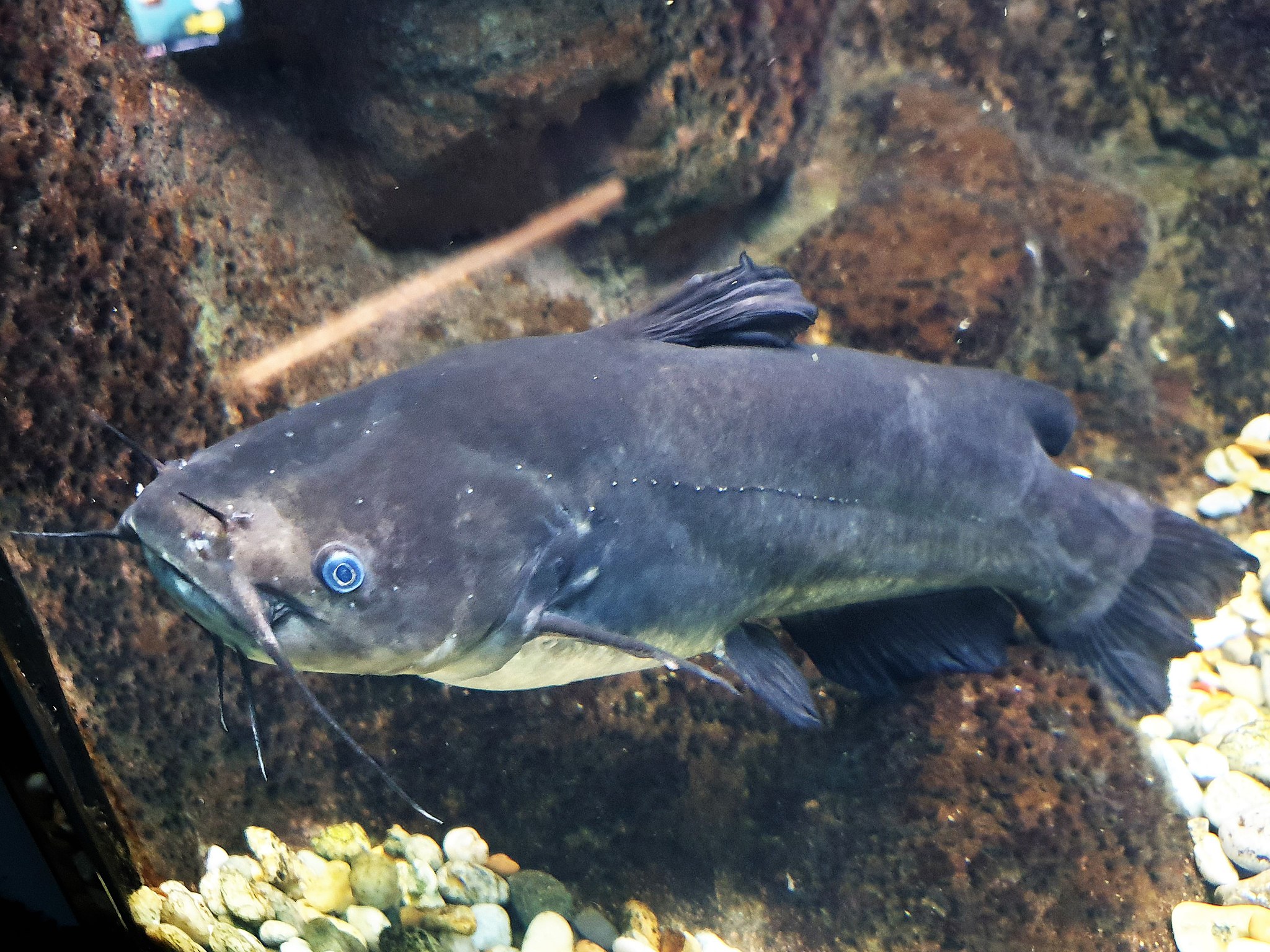
"File:Hal - Ameiurus melas - 1.jpg" by Emőke Dénes is licensed under CC BY-SA 4.0.

"Ameiurus melas" by fishesoftexas is licensed under CC BY-SA 4.0.
Invasive?/Where?
It is mostly found in larger rivers, but migrates towards the sea once in its life, as the offspring need salt water to develop. The young crabs then migrate in turn to freshwater. During these mass migrations upstream, it contributes to temporary local extinctions of native invertebrates, but it feeds primarily on aquatic plants. Its intense burrowing activity alters habitats along the way. Crabs can also be encountered on land as they avoid barriers in their migration. The species originated in Asia and was introduced to Europe in the early 20th century. They are carriers of the deadly fungus "crab plague", to which they themselves are resistant.
Appearance?
Unmistakable by the hair fur on the claws, but in females and juveniles it is not so pronounced. The dorsal carapace can be olive green to brown with dark spots, but there are also bluish and purple color variations. The carapace is finely serrated at the edge.
Distribution in Luxembourg: https://neobiota.lu/eriocheir-sinensis/
Please report the species, if you have seen it, via neobiota.lu

"Eriocheir sinensis" by ondrej-radosta is licensed under CC BY-NC 4.0

"Eriocheir sinensis" by sanher is licensed under CC BY-NC 4.0
Invasive?
Orconectes limosus, the Spiny-cheek crayfish and its congeners Pacifastacus leniusculus, the Signal crayfish and Procambarus fallax, the Marbled crayfish all originate from North America and nowadays inhabit almost all flowing waters. They are carriers of the deadly fungus "crayfish plague", to which they themselves are resistant. Since the crayfish grow faster, reproduce more strongly and are much more aggressive, they are biologically superior to the native European crayfish Astacus astacus and displace it even without transmission of the crayfish plague. Since the signal crayfish is very similar to the noble crayfish, it has also been released by humans into various lakes.
Where?
The crayfish are quite shy, which is why you can often only spot dead animals or moulting carapaces. Being nocturnal animals, they like to stay hidden in their hiding places or among aquatic plants during the day. They are omnivores. Both crayfish prefer cool rivers, but can also cope with warmer still waters.
Appearance?
The signal crayfish - Pacifastacus leniusculus


Are brownish to olive, carapace smooth. On the upper side of the claws at the joint there is a turquoise-white signal spot (name!), which is sometimes only weakly pronounced or even missing. The undersides of the claws are red.
Distribution in Luxembourg: https://neobiota.lu/pacifastacus-leniusculus/
Please report the species if you have seen it via the website link.
"Pacifastacus leniusculus, Ecrevisse de Californie Lac du Bourget_1( pêche INRA automne 2017)" and "Pacifastacus leniusculus, Ecrevisse de Californie Lac du Bourget_2 (pêche INRA automne 2017)" by photonat3873017107 is licensed under CC BY-NC-SA 2.0.
The crayfish - Orconectes limosus

Are brownish to olive in color, characteristic are the spines on the cheeks in front of the nuchal furrow and the orange tips of the claws.
Distribution in Luxembourg: https://neobiota.lu/orconectes-limosus/
Please report the species if you have seen it via the website link.
"Spinycheek crayfish" by Ansgar Gruber is licensed under CC BY-SA 2.0
The marble crayfish - Procambarus fallax
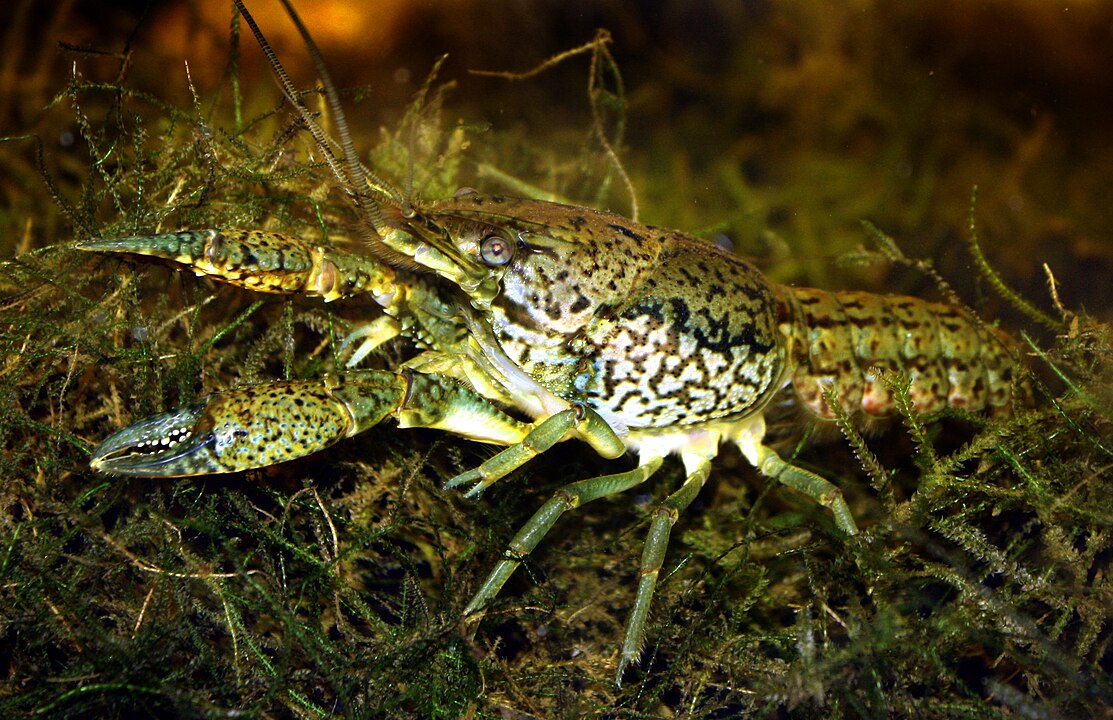
The marbled crayfish has a smooth carapace and is marbled. These patterns are often unique per individual.
"Marmorkrebs Lorenz Seebauer SingliserSee Germany" by Lorenz Seebauer is licensed under CC BY-SA 4.0.
Invasive?
Giant hogweed originated in the Caucasus and was introduced to Europe as an ornamental. And garden plant introduced to Europe. Its enormous growth height (over 3 m) and leaf area enables it to crowd out most native herbaceous plant species. It can form dense stands that absorb up to 80% of incoming light, displacing most light-demanding species. If it grows on riverbanks, the seeds can be dispersed by water for miles. In addition to ecological problems, tall invasive hogweed species also pose a serious health threat to humans. The plant secretes a clear watery sap that contains several photosensitizing furanocoumarins. Upon contact with human skin and in combination with ultraviolet radiation, these compounds cause severe burns to the skin (Branquart et al. 2010). After flowering, the plant parts die, leaving unattached riparian soil and the risk of erosion.
Where?
Giant hogweed grows on moist and nutrient-rich soils in ruderal habitats, along roadsides, riverbanks and forest edges, in abandoned or neglected meadows and in tall herbaceous communities. It is rarely found in older ecosystems such as forests, but can occur in open floodplain forests.
Appearance?
The stem is hollow and furrowed, it bears purple spots, especially in the lower part. It can grow up to 10 cm thick at the base. The leaves grow up to 1 (rarely up to 3) m long, they are 3-5-lobed with pinnatifid segments. The umbrella-like or plate-like inflorescence can reach 80 cm in diameter and consists of white to pink flowers. The ripe fruits are flat and have upward curved bristles, especially on the edge.
Distribution in Luxembourg/ Action Plan: https://neobiota.lu/heracleum-mantegazzianum/
"File:Jättebjörnloka (Heracleum mantegazzianum) i Väsmestorp, Sörby sn 5186.jpg"
by Gunnar Creutz is licensed under CC BY-SA 4.0.

"File:Riesen-Bärenklau 01 (Heracleum mantegazzianum).JPG" by Hajotthu is licensed under CC BY 3.0.
Invasive?
The Himalayan balsam is originally from the Himalayas and was brought to Europe as an ornamental plant. It has a very professional way of spreading ( watch the Video) and that is what makes it so dangerous to native plant life, as it threatens to out compete other plants. The flowers of the Himalaya balsam have the highest nectar production in Europe and attract numerous pollinators.
Since the end of the first decade of the 21st century, the Himalayan balsam has been increasingly spreading across the landscape, leaving riverbanks and colonizing other habitats such as roadsides and forests. An example of this is the Our valley between Stolzembourg and Dasbourg-Pont, where the balsam has managed to "jump" over the main road, climb the steep slopes and "invade" the oak forests. Meanwhile, Impatiens glandulifera also occurs in many forests and forest edges. Over the past 20 years, the spread of I. glandulifera into forest habitats has accelerated and may have been aided by the strong dispersal tendency of riparian populations, major anthropogenic or natural disturbance of forest ecosystems, increased use of forestry equipment capable of transporting seeds, and the high environmental tolerance of the species. Impacts of I. glandulifera in forest habitats may include negative effects on native plant and mycorrhizal fungal diversity. I. glandulifera may also have a negative impact on the growth of planted forest plants.
Where?
Found frequently in masses especially on the banks of many waterbodies, but also on roadsides, slopes, cities and forests. It prefers moist and relatively nutrient-rich soil.
Appearance?
The Himalayan balsam is an annual plant, it can be found from spring to summer. It grows quickly and can grow up to 3 meters high. The leaves grow opposite and are strongly serrated. The white, purple or pink flowers grow in flower groups (inflorescences) of 2- 14 flowers. The stem is mostly reddish, hollow and hairless.
Video of bursting capsule fruit
.jpg)
"Impatiens glandulifera Royle" by Udo Schmidt is licensed under CC BY-SA 2.0.
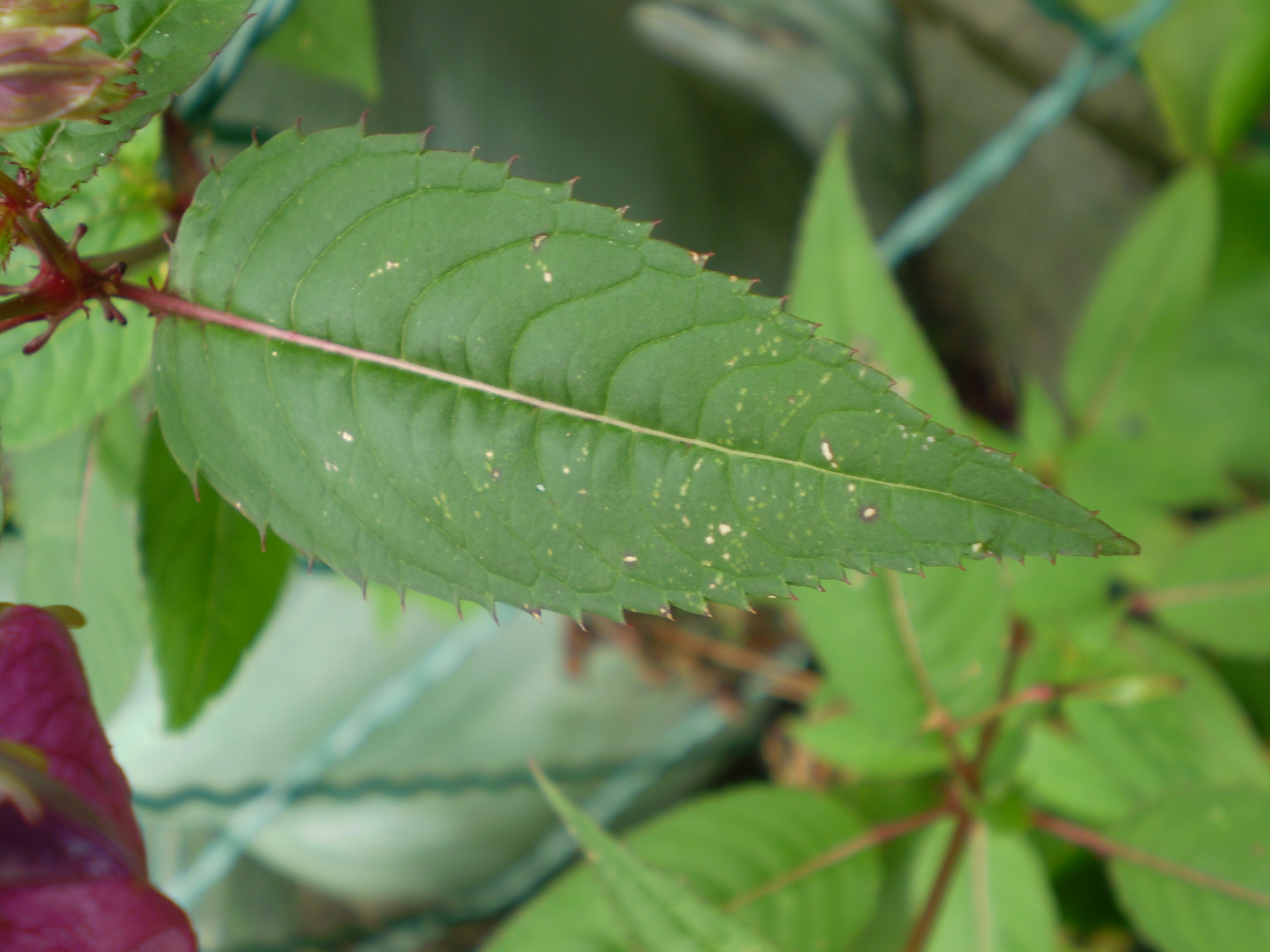
Impatiens glandulifera 0.05 R by Rob Hille is licensed under Public Domain
Invasive?
Japanese knotweed was introduced to Europe from East Asia in 1823 as an ornamental and garden plant. It and also its genetical intersections (hybrids) can be easily released into the wild, are competitive, and form dense stands that crowd out native vegetation. Although it can grow almost anywhere, all perennial knotweed prefers the banks of streams. The above-ground parts die back in winter, leaving bare banks that are subject to erosion. No seeds are produced, but Fallopia japonica reproduces clonally. Stems and roots easily break into small pieces, and a new plant can regenerate from the fragments. The main ways of spreading are transport of garden waste and soil contaminated with root fragments. If the plant is strongly consolidated on riverbanks, it is also spread by floods and can easily establish itself downstream.
Where?
Like other knotweed, Japanese perennial knotweed colonizes a wide range of habitats, with a preference for moist and nitrogenous soils. It prefers sunny spots or partial shade. This pioneer plant spreads in both ruderal and semi-natural habitats, including riparian areas and open woodlands.
Appearance? Confusion?
The identification of knotweed species is not always easy, especially of the existing very similar looking hybrid. In 2017, the museum was able to show that in Luxembourg the cross F. × bohemica is more common than Fallopia japonica. It is a natural fertile hybrid of Japanese knotweed (Fallopia japonica) and Sakhalin knotweed (Fallopia sachalinensis).
Fallopia x bohemica has characteristics of both Japanese knotweed and Sakhalin knotweed. There are leaves with a rectangular as well as with a heart-shaped base. Often a distinction is not clear, so that finds in doubt can also be called "Fallopia spec."
Distribution in Luxembourg / Action Plan: https://neobiota.lu/helianthus-tuberosus/
Invasive?
Helianthus tuberosus is native to central and eastern North America. Probably cultivation for eating the root tubers brought him to Europe. Under Western European climatic conditions, the plant does not produce viable seeds and reproduces vegetatively. Tubers and root pieces (rhizomes) are transported by rodents and running water, especially during winter floods. The plant can form dense and persistent monocultures along rivers, where it usually displaces native species by shading and competing for other resources..
Where?
Helianthus tuberosus, prefers light-rich, sandy, moist and nutrient-rich soils. It thrives best in locations that are repeatedly flooded by high water (riverbanks), but can also be found in ruderal areas and in agriculture.
Appearance?
The plant grows up to 3 m high, the stem is round and rough hairy. The stalked leaves are broad-lanceolate, with serrated margins, rough on top and finely soft-hairy underneath. They grow up to 25 cm long and 10 cm wide and are opposite in the lower part of the stem, alternate above. The yellow flowers are erect and 4 to 8 cm in diameter. Tongue and tube flowers are yellow. The plant blooms from September to October.
Distribution in Luxembourg / Action Plan: https://neobiota.lu/helianthus-tuberosus/
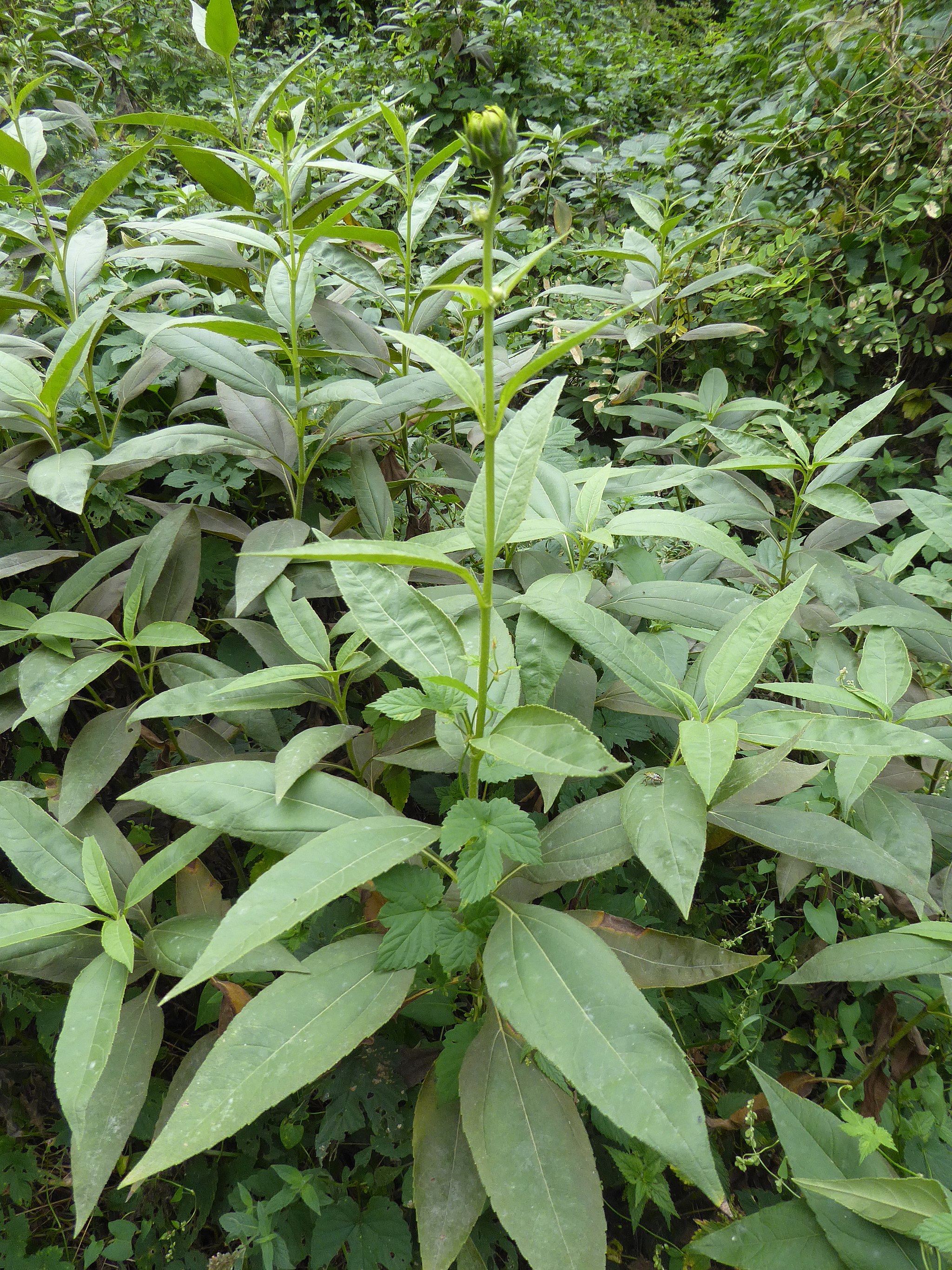
Jerusalem artichoke habitus
"File:Helianthus tuberosus Paludi 02.jpg" by Syrio is licensed under CC BY-SA 4.0.
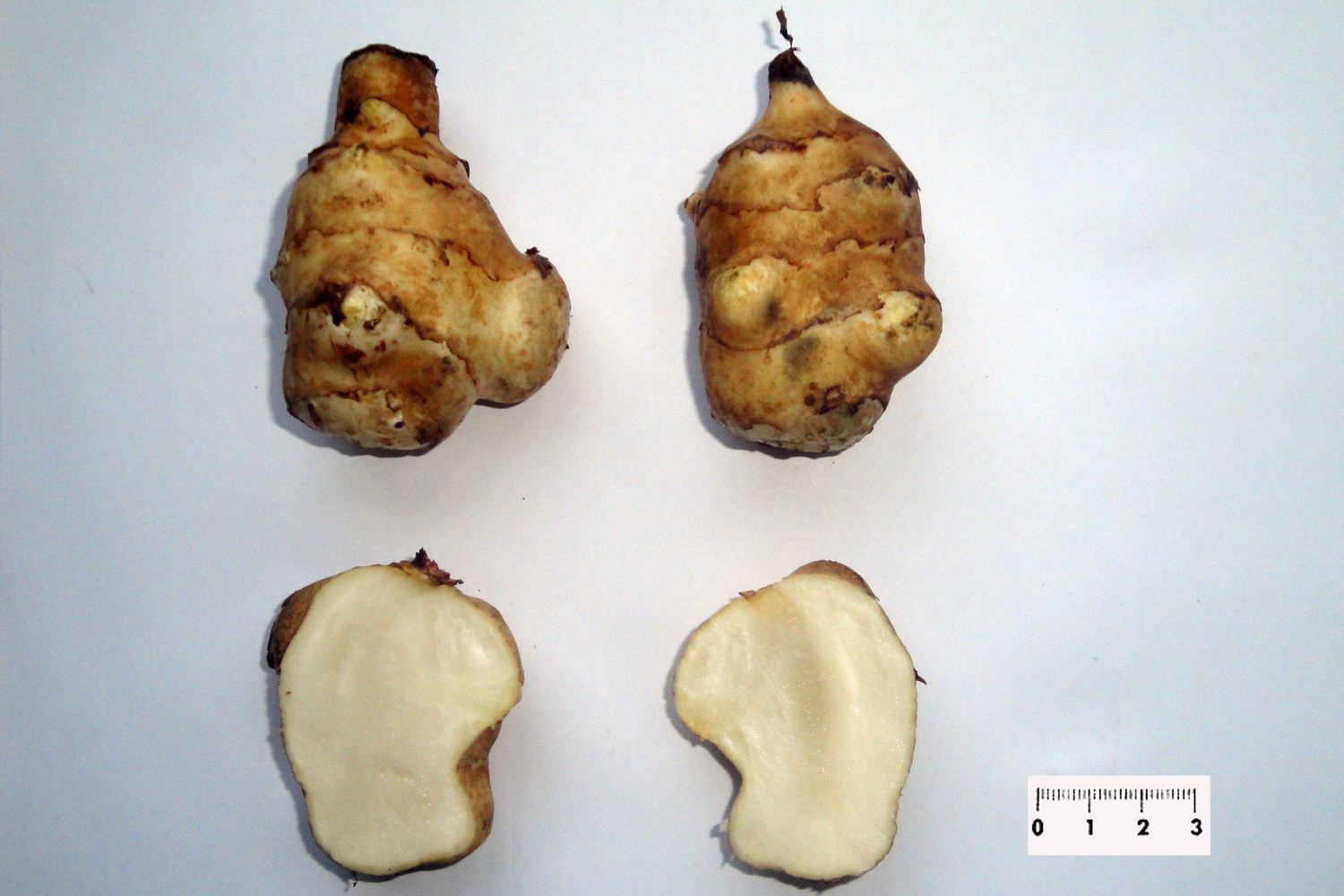
Edible root tubers of Jerusalem artichoke
"Helianthus tuberosus 'White Round', Tsaghkadzor, in culture" by Vahe Martirosyan is licensed under CC BY 2.0.

Jerusalem artichoke flowers
"Helianthus tuberosus Paludi 06" by Syrio is licensed under CC BY-SA 4.0.
Invasive?
The nutria is a rodent from South America, which was introduced to Europe mainly for fur farming. It feeds on stems of aquatic plants and thus destroys reed zones and fish nurseries. It also plunders the nests of marsh birds.
Where?
The nutria lives on the banks of wide rivers or lakes and also in other wetlands. They build a den at the water's edge and defend their territory. Often nutria live together in pairs or groups. It can often be observed swimming or gnawing on the shore.
Aussehen?
Nutria have a yellow-brown to black colored fur, their nail teeth are orange. The long rat-like tail is scaled and somewhat hairy. They have small ears and long thick whiskers, between the 1st and 4th toe of the hind feet are webbed.
Distribution in Luxembourg: https://neobiota.lu/myocastor-coypus/
Please report the species, if you have seen it, via neobiota.lu
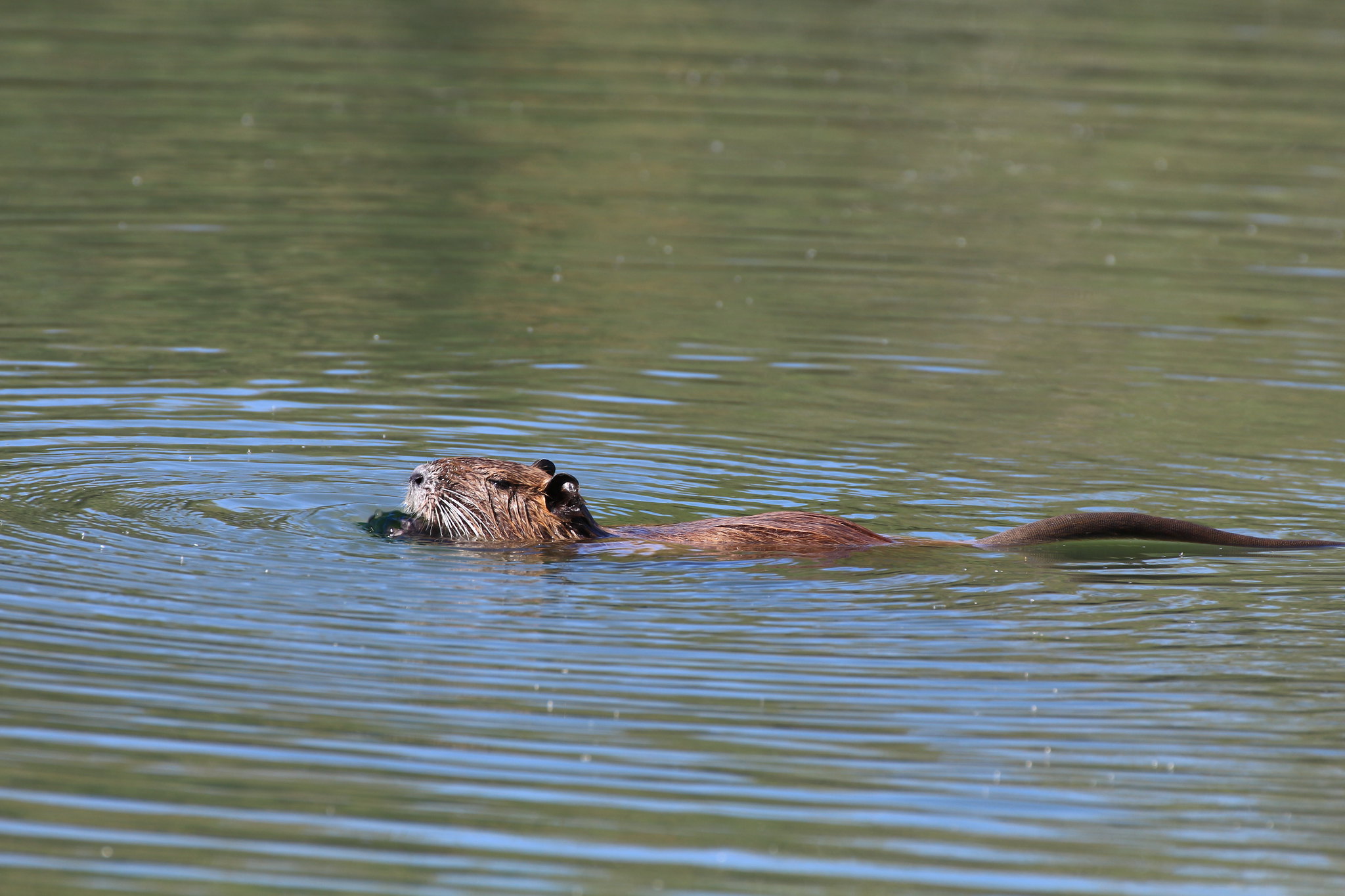
"Stéphanie Baumard - Ragondin (Myocastor coypus) - Camargue" by Images pour des mots is marked with CC0 1.0
Invasive?
The jellyfish probably originated in the Yangtze River in China. How the freshwater jellyfish came to Europe is unclear - but probably as a stowaway of an imported pond plant. Since it reproduces asexually by division, it can spread rapidly. The freshwater jellyfish probably has no major ecological impact on native animal and plant species.
Where?
It is found in warm, clear, slow-moving and stagnant waters. Most of the time it lives in the polyp stage attached to plants. It needs water temperatures of at least 25°C to develop into a medusa. In warm summers the jellyfish often appear in masses, they are harmless to humans.
Appearance?
Their rather small whitish, transparent umbrella has a diameter of about 6 mm to 20 mm. It is the only species of the native cnidarians that besides the polyp stage has a medusa stage, so it looks like a classic jellyfish.
Invasive?
Trachemys is a genus of turtles belonging to the family Emydidae. Trachemys spec. probably entered Europe as pets through the pet trade. They are native to the southern United States and northern Mexico, but have also been introduced to us due to pet releases and are displacing the native European pond slider (Emys orbicularis) from their habitat in many areas.
Where?
The turtles live in slow-moving rivers as well as floodplains, marshes, temporary wetlands, and ponds.
Appearance?
There are three subspecies, two of which are found in Luxembourg to date. The yellow-bellied slider (Trachemys scripta scripta) has an oval greenish to brownish dorsal carapace about 12-21cm, a yellow ventral shield and narrow yellow chin stripes. The red-eared slider (Trachemys scripta elegans) can be clearly recognized by its red temporal stripes.
Distribution map in Luxembourg: https://neobiota.lu/trachemys-scripta-scripta-2/
Please report the species, if you have seen it, via neobiota.lu

The yellow-bellied slider (Trachemys scripta scripta) has an oval greenish to brownish dorsal carapace about 12-21cm, a yellow ventral shield and narrow yellow chin stripes.
"Male slider (Trachemys scripta scripta), Botanic Garden, Munich, Germany" by Diego Delso, CC BY-SA 3.0

The red-eared slider (Trachemys scripta elegans) can be clearly recognized by its red temporal stripes.
"Red-eared Slider Turtle (trachemys scripta elegans)" by woodleywonderworks is licensed under CC BY 2.0.
Invasive?
The quagga mussel is apparently displacing the zebra mussel (D. polymorpha), which was introduced more than 100 years ago and is found almost everywhere. It is spreading further and further south via large rivers and canals.
Where?
With the help of its adhesive foot, it can attach itself to stones, concrete walls or ship hulls. It owes its rapid spread to its dispersal mechanism via the free larvae, which only attach themselves to a substrate after about over a week.
Appearance?
The colors are very different, the has a beige to dark brown shell and is often clear longitudinally striped. The quagga mussel is recognizable by rounded shell sides. The shell sides are also asymmetrical, if you look at the shell from the side they are wavy and not flat on top of each other as in the native triangular mussel.
Invasive?
The stone moroko originates from river systems in East Asia, it was unintentionally first imported to Romania via eggs in 1960. It is insensitive to temperature fluctuations and tolerates low O2 levels in the water, therefore it is considered very adaptable which is an advantage over native species. It has a negative impact on other fish and amphibian species due to competition for food and spawn predation. The stone moroko selectively eats larger zooplankton species (Crustacea), which leads to increased phytoplankton density and thus favors the eutrophication of water bodies.
Where?
It occurs both on the shore zones of still waters and in flowing waters, it prefers summer warmed zones and plant-rich waters.
Appearance?
The stone moroko is a small fish species and rarely grows larger than 10 cm. The scales are metallic shimmering, and along the body side, especially in young fish a black-blue stripe.
Distribution in Luxembourg: https://neobiota.lu/pseudorasbora-parva/
Invasive?
This perennial submerged plant forms dense populations that often colonize entire water bodies, restricting water movement, blocking light, creating anoxic conditions, and accelerating sediment deposition. Because of its rapid nutrient uptake and very high growth rate, the species displaces native aquatic plants.
The species' original range in North America extends from Quebec through Montana to Washington, and south to North Carolina and California. Spread is by vegetative propagation: shoot parts are transported widely by flowing water, marine traffic, water sports equipment (including fishing), and waterfowl. A new waterweed population grows from the shoot fragments.
Where?
Elodea nuttallii is an underwater plant that grows in various types of freshwater habitats, from stagnant to slow-flowing waters. It is very tolerant of water pollution and prefers warm, eutrophic and calcareous waters. It is often found in species-poor aquatic plant communities. It is more nutrient tolerant than its sister species Elodea canadiensis and can even survive in wastewater with concentrations up to 27.2 mg NH4+-N/l. Thus, it benefits more from water pollution than E. canadensis. Elodea nuttallii can form dominant stands in nutrient-rich, stagnant or slow-flowing waters. In hypertrophic waters, dominance stands of narrowleaf waterweed can occur especially after nutrient levels are reduced.
Appearance?
In addition to the Canadian pondweed (E. canadensis) and the Western waterweed, the Argentine waterweed (E. callitrichoides; with flat, longer leaves) is also found in our area, but all species are quite difficult to distinguish. Waterweed species are perennial submerged aquatic plants. Their densely leafy shoots creep or grow erect. They are about 1 mm thick and up to 300 cm long. The light green narrow leaves of this species are 3-cornered to linear, long-pointed, up to 10 mm long and 0.4 - 1.5 (-2.4) mm wide. In the lower stem area they are alternately arranged, in the upper area they are in mostly 3-fold whorls. In contrast to the Canadian pondweed (E. canadensis), the leaves of the Western waterweed are narrower, long-pointed, recurved and more or less strongly spirally twisted.
Distribution in Luxembourg: https://neobiota.lu/elodea-nuttallii/
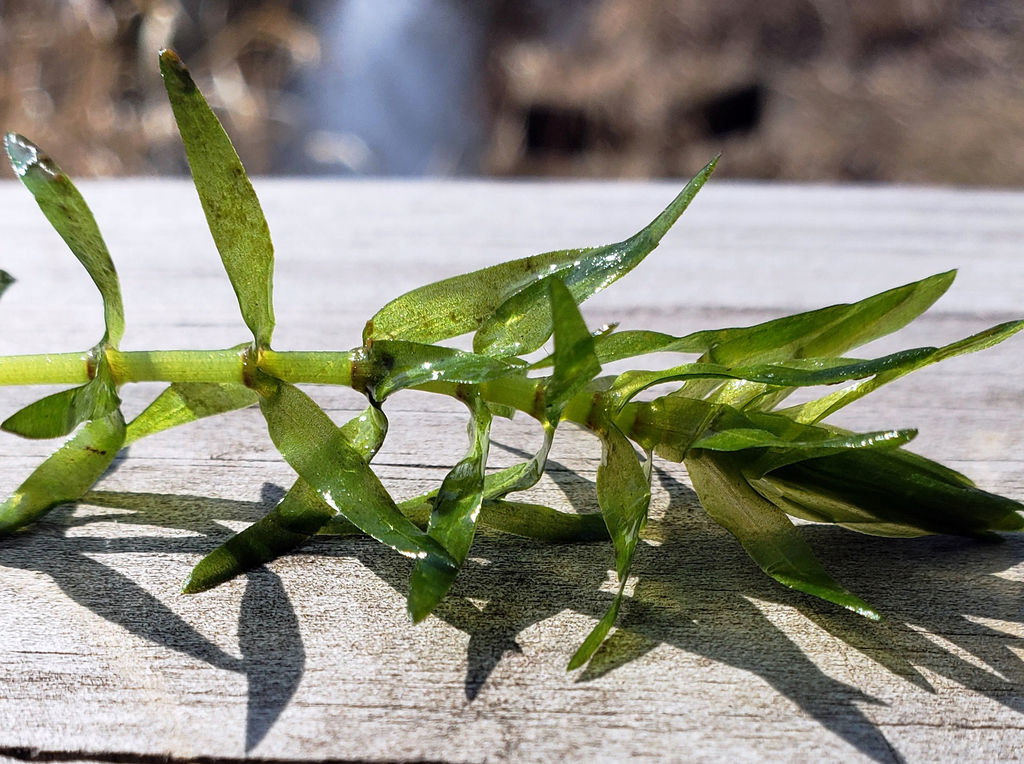
Linear, long pointed light green leaves of narrow-leaved waterweed.
"Elodea nuttallii" by aarongunnar is licensed under CC BY 4.0.
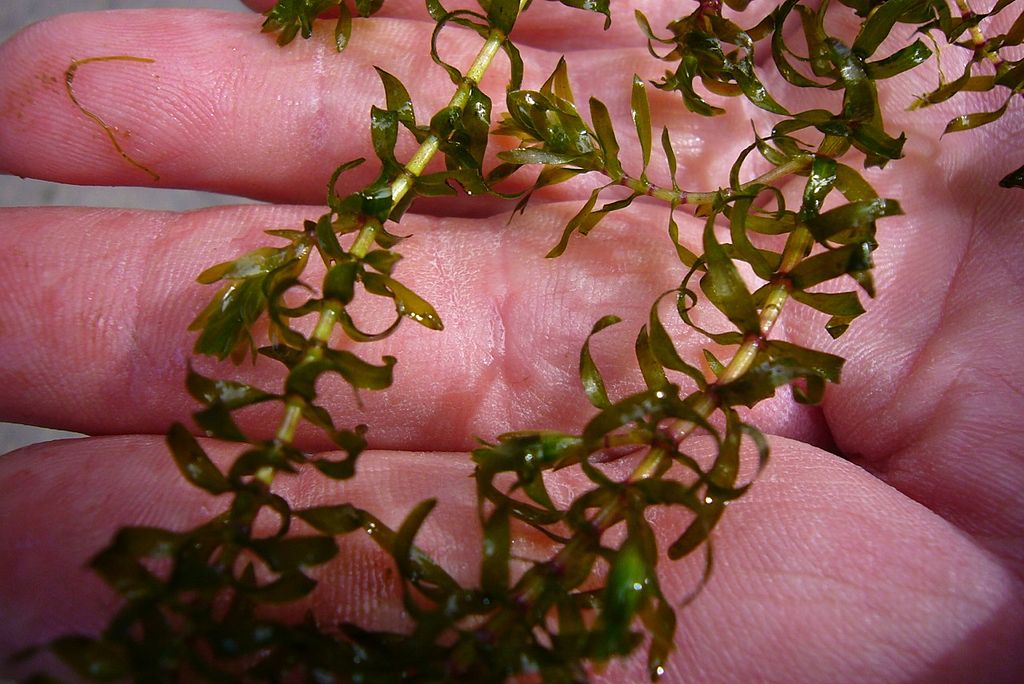
A slight spiral twist can be seen on some leaves, this distinguishes E. nutallii from E.canadensis.
"File:Elodea nuttallii* (8405291256).jpg" by Radio Tonreg from Vienna, Austria is licensed under CC BY 2.0.

Dense dominant stands of the
Narrow-leaved waterweed.
"Elodea nuttallii" by ahospers is licensed under CC BY 4.0
This website uses no external trackers, no analytics, just session cookies and values your online privacy.


